Abstract
The relationship between corneal arcus (arcus senilis) and mortality from coronary heart disease (CHD) and cardiovascular disease (CVD) is examined in a prospective study of White men (n = 3,930) and women non-hormone users (n = 2,139), ages 30-69, followed for an average of 8.4 years as part of the Lipid Research Clinics Mortality Follow-up Study. After excluding those with clinically manifest CHD at baseline, corneal arcus was strongly associated with CHD and CVD mortality only in hyperlipidemic men ages 30-49 years, for whom the relative risk for CHD and CVD death was 3.7 and 4.0, respectively, after adjusting for age, total cholesterol, HDL cholesterol, and smoking status using a Cox proportional hazards model. Among 30-49 year old males, corneal arcus appears to be a prognostic factor for CHD, independent of its association with hyperlipidemia in this age-group, of about the same magnitude as other common risk factors, underscoring the usefulness of corneal arcus as a prognostic factor to the practicing clinician.
Full text
PDF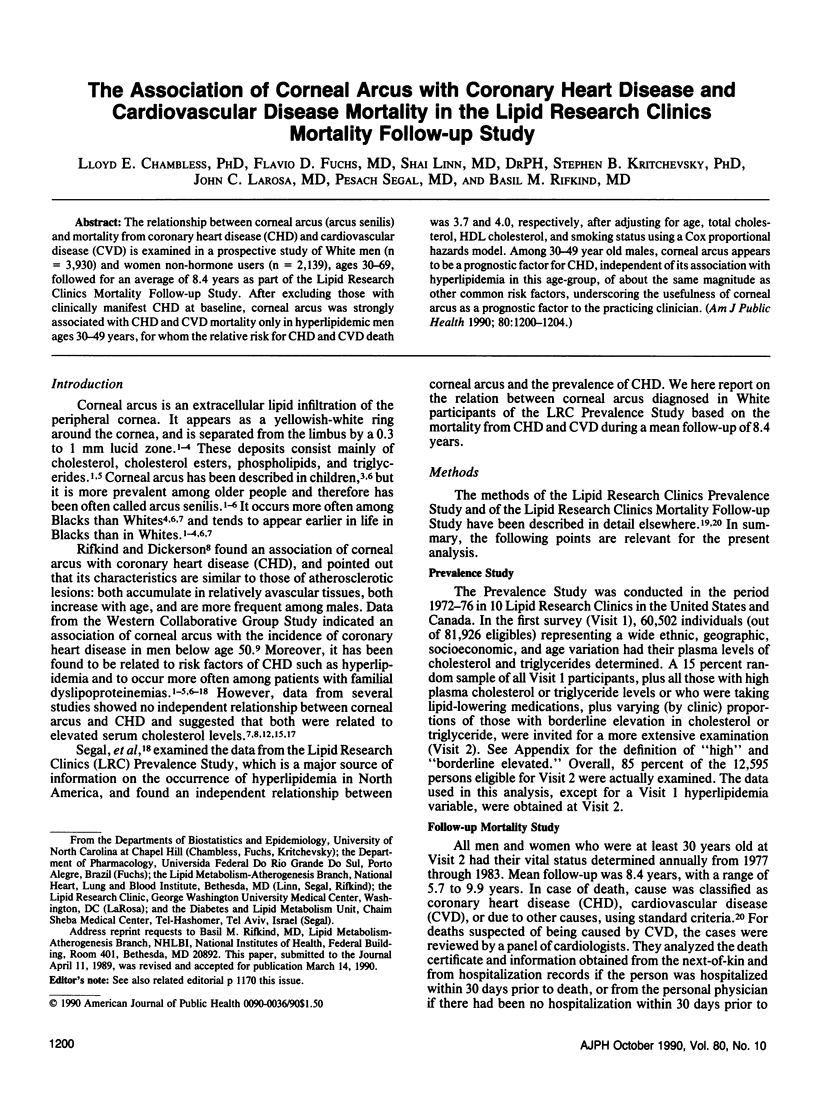
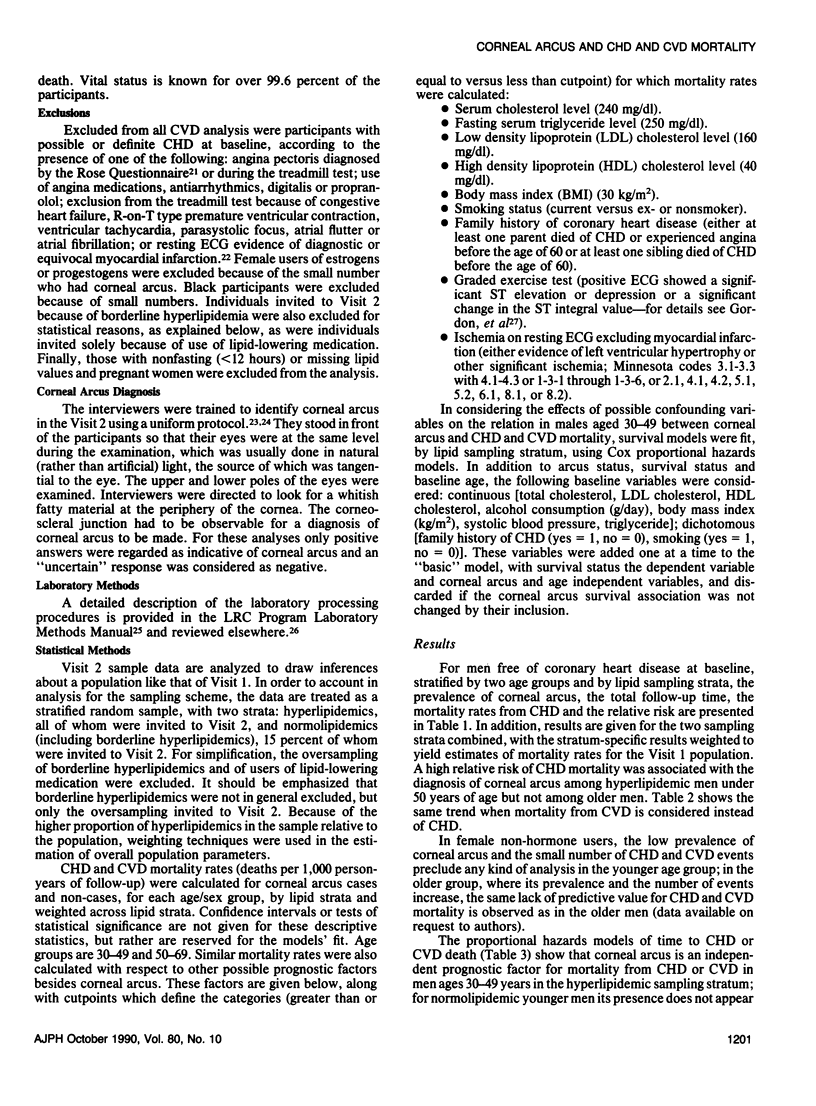
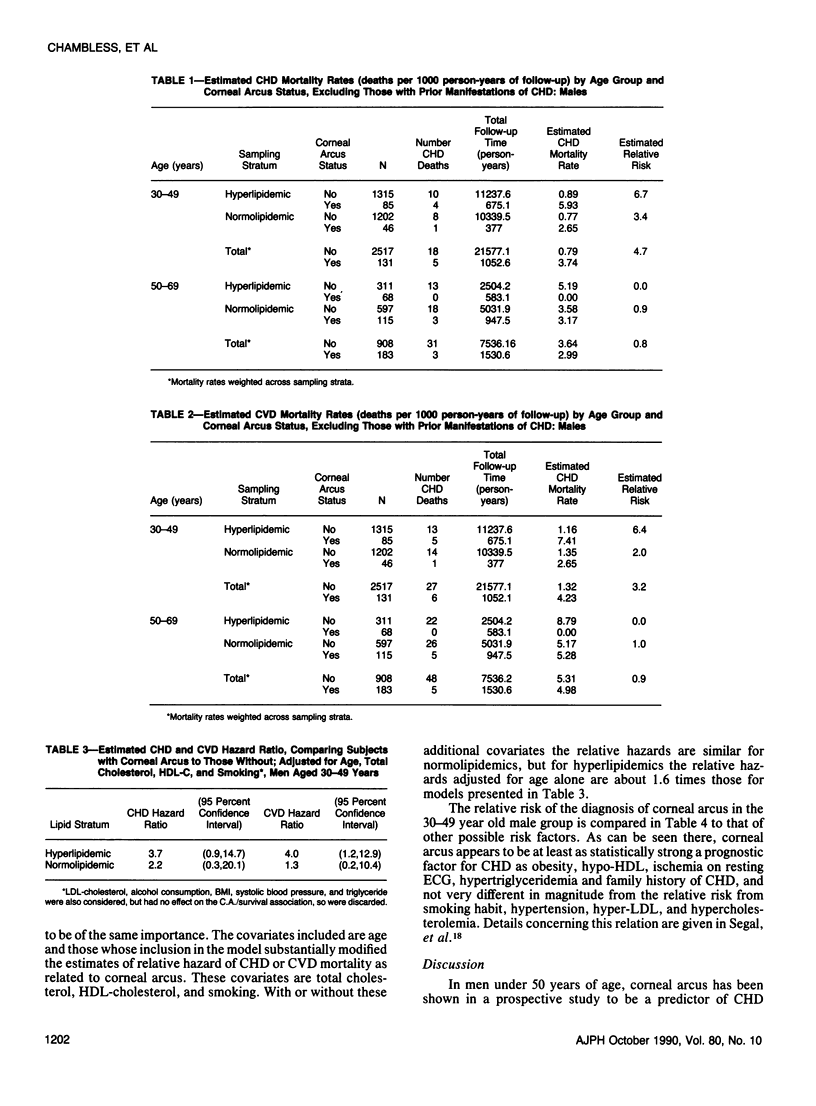
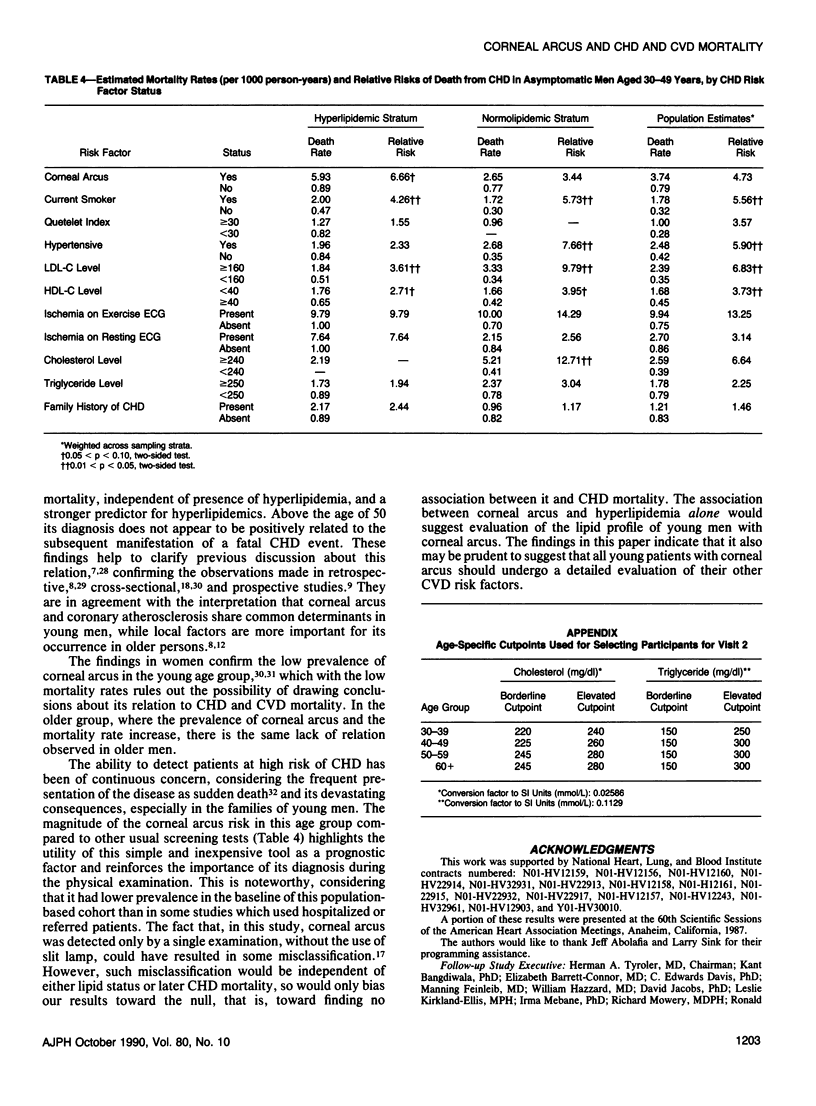
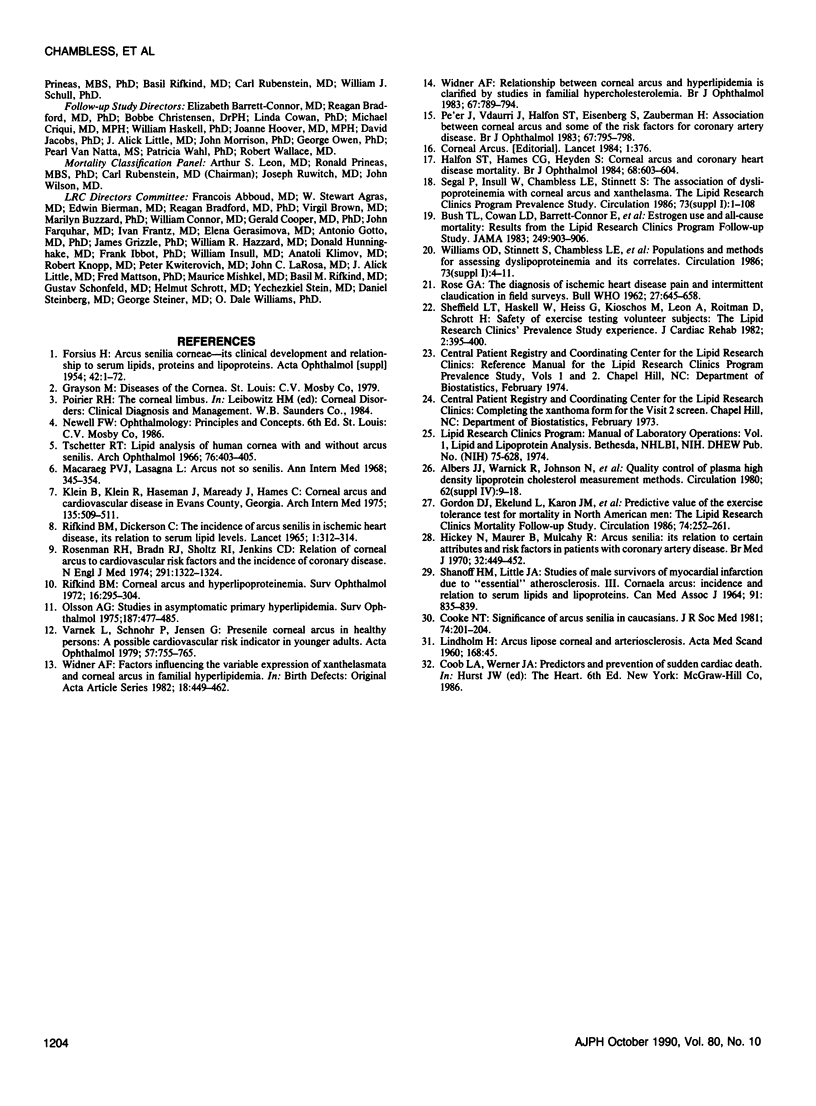
Selected References
These references are in PubMed. This may not be the complete list of references from this article.
- Bush T. L., Cowan L. D., Barrett-Connor E., Criqui M. H., Karon J. M., Wallace R. B., Tyroler H. A., Rifkind B. M. Estrogen use and all-cause mortality. Preliminary results from the Lipid Research Clinics Program Follow-Up Study. JAMA. 1983 Feb 18;249(7):903–906. doi: 10.1001/jama.249.7.903. [DOI] [PubMed] [Google Scholar]
- Cooke N. T. Significance of arcus senilis in Caucasians. J R Soc Med. 1981 Mar;74(3):201–204. doi: 10.1177/014107688107400308. [DOI] [PMC free article] [PubMed] [Google Scholar]
- Gordon D. J., Ekelund L. G., Karon J. M., Probstfield J. L., Rubenstein C., Sheffield L. T., Weissfeld L. Predictive value of the exercise tolerance test for mortality in North American men: the Lipid Research Clinics Mortality Follow-up Study. Circulation. 1986 Aug;74(2):252–261. doi: 10.1161/01.cir.74.2.252. [DOI] [PubMed] [Google Scholar]
- Halfon S. T., Hames C. G., Heyden S. Corneal arcus and coronary heart disease mortality. Br J Ophthalmol. 1984 Aug;68(8):603–604. doi: 10.1136/bjo.68.8.603. [DOI] [PMC free article] [PubMed] [Google Scholar]
- Hickey N., Maurer B., Mulcahy R. Arcus senilis: its relation to certain attributes and risk factors in patients with coronary heart disease. Br Heart J. 1970 Jul;32(4):449–452. doi: 10.1136/hrt.32.4.449. [DOI] [PMC free article] [PubMed] [Google Scholar]
- Klein B., Klein R., Haseman J., Maready J., Hames C. Corneal arcus and cardiovascular disease in Evans County, Georgia. Arch Intern Med. 1975 Apr;135(4):509–511. [PubMed] [Google Scholar]
- LINDHOLM H. Arcus lipoides corneae and arteriosclerosis. Acta Med Scand. 1960 Sep 21;168:45–49. doi: 10.1111/j.0954-6820.1960.tb06640.x. [DOI] [PubMed] [Google Scholar]
- Macaraeg P. V., Jr, Lasagna L., Snyderb Arcus not so senilis. Ann Intern Med. 1968 Feb;68(2):345–354. doi: 10.7326/0003-4819-68-2-345. [DOI] [PubMed] [Google Scholar]
- Olsson A. G. Studies in asymptomatic primary hyperlipidaemia II. Clinical findings. Acta Med Scand. 1975 Jun;197(6):477–485. doi: 10.1111/j.0954-6820.1975.tb04956.x. [DOI] [PubMed] [Google Scholar]
- Pe'er J., Vidaurri J., Halfon S. T., Eisenberg S., Zauberman H. Association between corneal arcus and some of the risk factors for coronary artery disease. Br J Ophthalmol. 1983 Dec;67(12):795–798. doi: 10.1136/bjo.67.12.795. [DOI] [PMC free article] [PubMed] [Google Scholar]
- RIFKIND B. M. THE INCIDENCE OF ARCUS SENILIS IN ISCHAEMIC HEART-DISEASE ITS RELATION TO SERUM-LIPID LEVELS. Lancet. 1965 Feb 6;1(7380):312–314. doi: 10.1016/s0140-6736(65)91044-5. [DOI] [PubMed] [Google Scholar]
- ROSE G. A. The diagnosis of ischaemic heart pain and intermittent claudication in field surveys. Bull World Health Organ. 1962;27:645–658. [PMC free article] [PubMed] [Google Scholar]
- Rifkind B. M. Corneal arcus and hyperlipoproteinaemia. Surv Ophthalmol. 1972 Mar-Apr;16(5):295–304. [PubMed] [Google Scholar]
- Rosenman R. H., Brand R. J., Sholtz R. I., Jenkins C. D. Relation of corneal arcus to cardiovascular risk factors and the incidence of coronary disease. N Engl J Med. 1974 Dec 19;291(25):1322–1324. doi: 10.1056/NEJM197412192912503. [DOI] [PubMed] [Google Scholar]
- SHANOFF H. M., LITTLE J. A. STUDIES OF MALE SURVIVORS OF MYOCARDIAL INFARCTION DUE TO "ESSENTIAL" ATHEROSCLEROSIS. 3. CORNEAL ARCUS: INCIDENCE AND RELATION TO SERUM LIPIDS AND LIPOPROTEINS. Can Med Assoc J. 1964 Oct 17;91:835–839. [PMC free article] [PubMed] [Google Scholar]
- Tschetter R. T. Lipid analysis of the human cornea with and without arcus senilis. Arch Ophthalmol. 1966 Sep;76(3):403–405. doi: 10.1001/archopht.1966.03850010405020. [DOI] [PubMed] [Google Scholar]
- Varnek L., Schnohr P., Jensen G. Presenile corneal arcus in healthy persons. A possible cardiovascular risk indicator in younger adults. Acta Ophthalmol (Copenh) 1979 Oct;57(5):755–765. doi: 10.1111/j.1755-3768.1979.tb01841.x. [DOI] [PubMed] [Google Scholar]
- Williams O. D., Stinnett S., Chambless L. E., Boyle K. E., Bachorik P. S., Albers J. J., Lippel K. Populations and methods for assessing dyslipoproteinemia and its correlates. The Lipid Research Clinics Program Prevalence Study. Circulation. 1986 Jan;73(1 Pt 2):I4–11. [PubMed] [Google Scholar]
- Winder A. F. Factors influencing the variable expression of xanthelasmata and corneal arcus in familial hypercholesterolaemia. Birth Defects Orig Artic Ser. 1982;18(6):449–462. [PubMed] [Google Scholar]
- Winder A. F. Relationship between corneal arcus and hyperlipidaemia is clarified by studies in familial hypercholesterolaemia. Br J Ophthalmol. 1983 Dec;67(12):789–794. doi: 10.1136/bjo.67.12.789. [DOI] [PMC free article] [PubMed] [Google Scholar]


